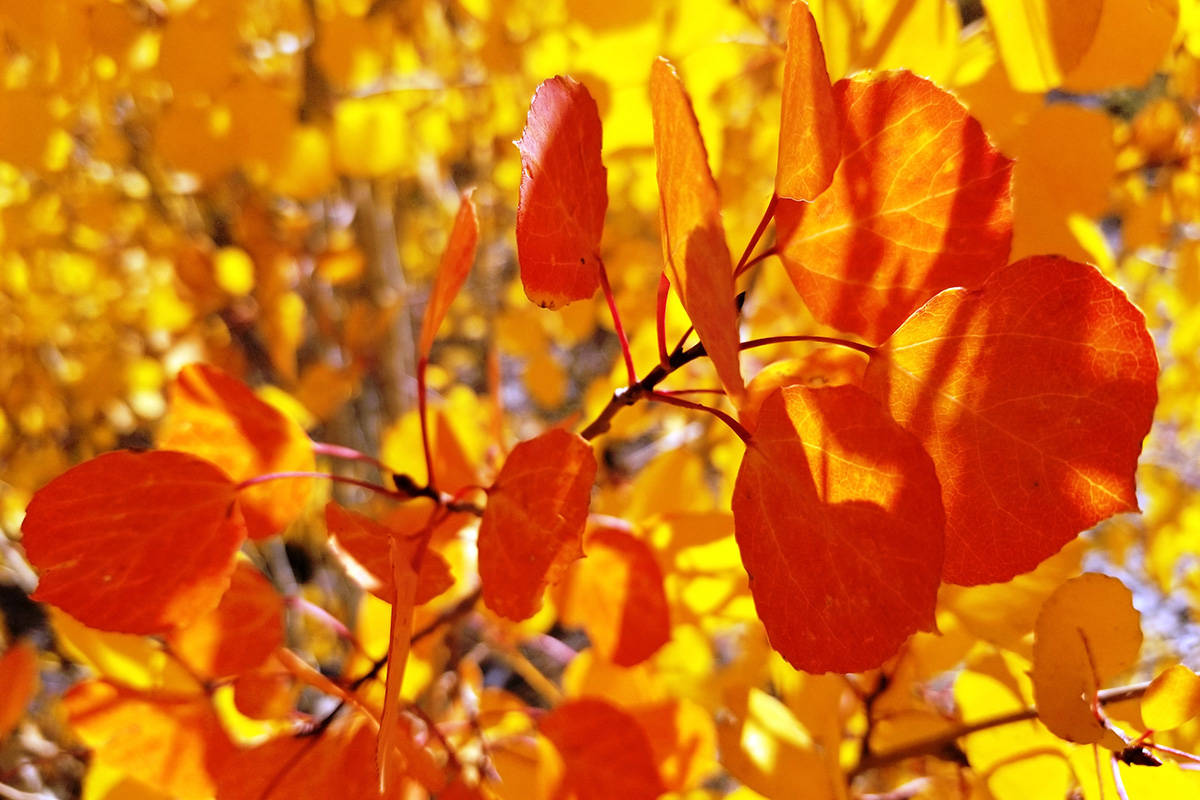Foliage season dawning at Mount Charleston

Fall at Mount Charleston means bold strokes of autumn color on mountainsides and gold aspen coins tossed along the trail. Hues of yellow and light orange last only a few weeks, and that transition starts about now with splashes of brightness contrasting pine greenery.
“Generally, we say around mid-September to the end of October are good times to see the fall colors,” said Katy Gulley, a U.S. Forest Service natural resource specialist for Southern Nevada’s popular recreation and wilderness area.
Changes in weather and a diversity of leafy locations in Mount Charleston’s canyons make it difficult to pinpoint when and where the best displays will be. In past years, my approach has been to visit the higher elevations of Lee Canyon in September and plan return trips if my first fall foliage hike proves underwhelming. The more visits to the Spring Mountains to check on leaf chemistry, the better my autumn state of mind.
Longer hikes are a smart strategy because such commitment affords both close-up tree time and stunning panoramas. Before the difficult climbing begins, several trails pass right through aspen groves where the glow is felt and quaking of leaves can be heard.
“The Cathedral Rock trail and the Cathedral Rock observation point have really great vistas of the fall colors happening all around,” Gulley said. “So does Upper Bristlecone, and in one spot on the trail you’ll find almost a tunnel of aspen trees.”
Other challenging yet gratifying hikes include Trail Canyon and South Loop, which eventually reward hard work with gorgeous big-picture views of the surrounding mountains with wide patches and steep avalanche chutes of vibrant color.
Mount Charleston visitors who decide against longer hikes can still enjoy plenty of autumn color by walking only 30 minutes past the start of the Upper Bristlecone trail near Lee Canyon ski area. Hiking just 30 minutes along the Cathedral Rock or South Loop trails in Kyle Canyon also offers quality time with aspen. Other easier-access ideas include parking and taking short strolls in areas near the trailheads of Trail Canyon or Mary Jane Falls. Aspens are also part of the experience at Deer Creek picnic area, located along state Route 158 between the two canyons.
My best leaf luck typically occurs in the first days of October, when last year a yellow river of aspen on the South Loop trail appeared poised to sweep away dear friends. The most stunning autumn display happened for me one September afternoon in Trail Canyon, where an ongoing mural on my left revealed huge swaths of light orange and yellow replacing the mountainside’s usual light green and gray.
Cathedral Rock is a favorite, packed with memories of my sons hiking through autumn splendor before winter’s wind, cold and snow challenge Mount Charleston’s trees and critters. Upper Bristlecone is the trail that’s given me $1 million worth of gold aspen coins through the years. There, aspen leaves collect along the hiking path, gather with pine cones on the forest floor and take on the look of Christmas tree ornaments when they land on pine branches.
Autumn’s yellows and light oranges have been there throughout spring and summer, Gulley explained. The green just has the upper hand until temperatures drop, daylight dwindles and trees move to energy-saving mode in September.
After a “cost-benefit analysis,” she said, the trees decide to shut down food production. When that happens, chlorophyll breaks down and the associated green color begins to disappear.
“A lot of chemical processes go into the fall colors,” Gulley said. “The carotenoids, the yellow and orange, are always there, but they’re overpowered by the chlorophyll. Now the yellow and orange get to shine.”
Admittedly enamored with her outdoor workplace for the past eight years, Gulley said she appreciates this seasonal chapter of a survival story that includes majestic pines and firs as well as more than 20 endemic plant and animal species that make Mount Charleston their “sky island” home.
“Beyond the color of it all, I just really admire the story and the ecology,” she said. And for most Southern Nevadans, driving to see Mount Charleston’s fall colors takes less than an hour.
“The juxtaposition of being in the big, wide-open desert and then coming up to the mountain with all of the towering, vibrant green trees and the cool air makes it feel exceptionally special,” Gulley said.
For everyone fortunate enough to escape to Mount Charleston in the coming weeks, shared responsibility goes along with the splendor and enjoyment of cooler, crisper and colorful autumn days.
“It’s really important that we view with our eyes and leave only footprints,” Gulley said. “Enjoy the trees and don’t leave your initials.” Carved initials can be death sentences for aspens because such cutting exposes inner tree layers that are typically protected from fungal infections and pathogens.
Natalie Burt, a former news reporter at the Review-Journal, has lived in Southern Nevada for 31 years and spends as much time as possible enjoying the outdoors here. Contact her at nvburt@gmail.com.